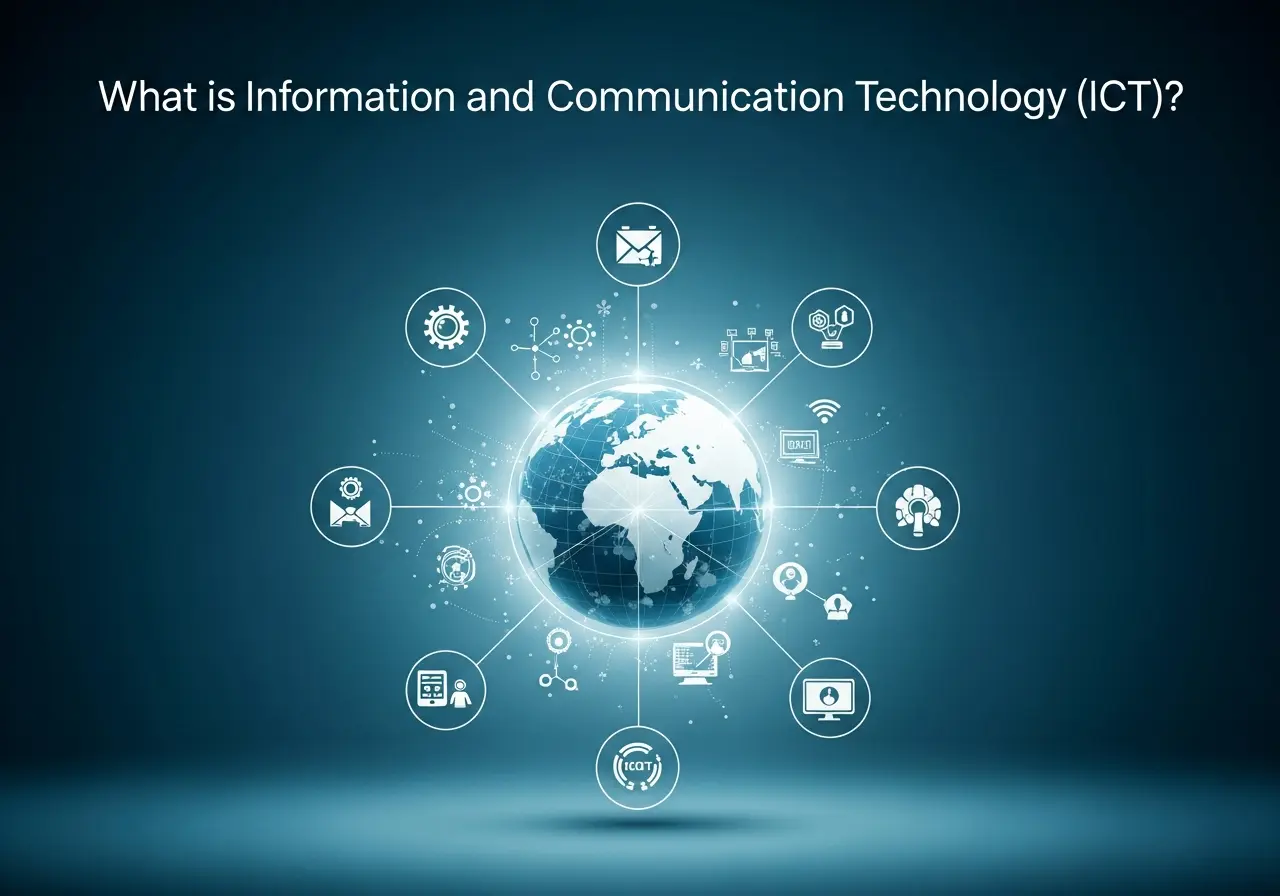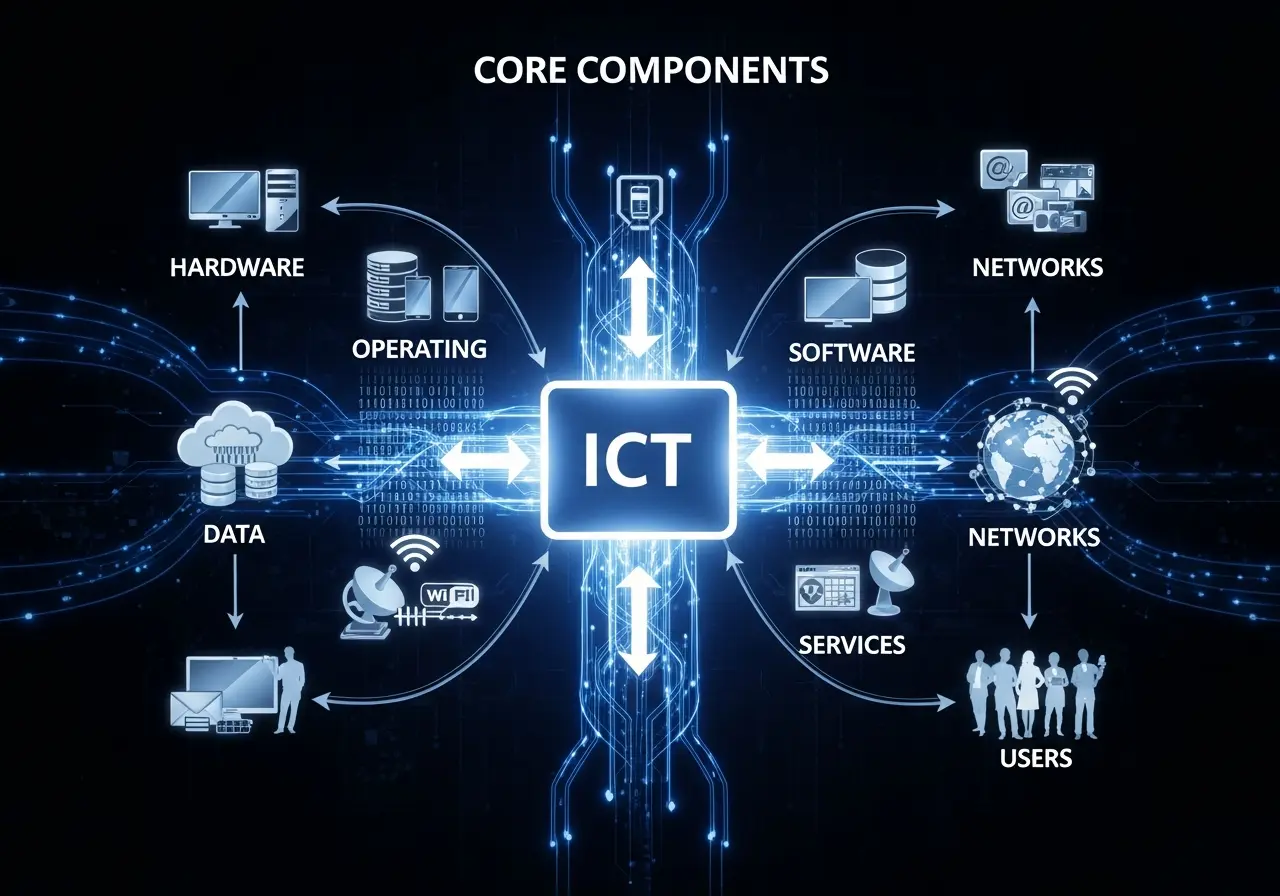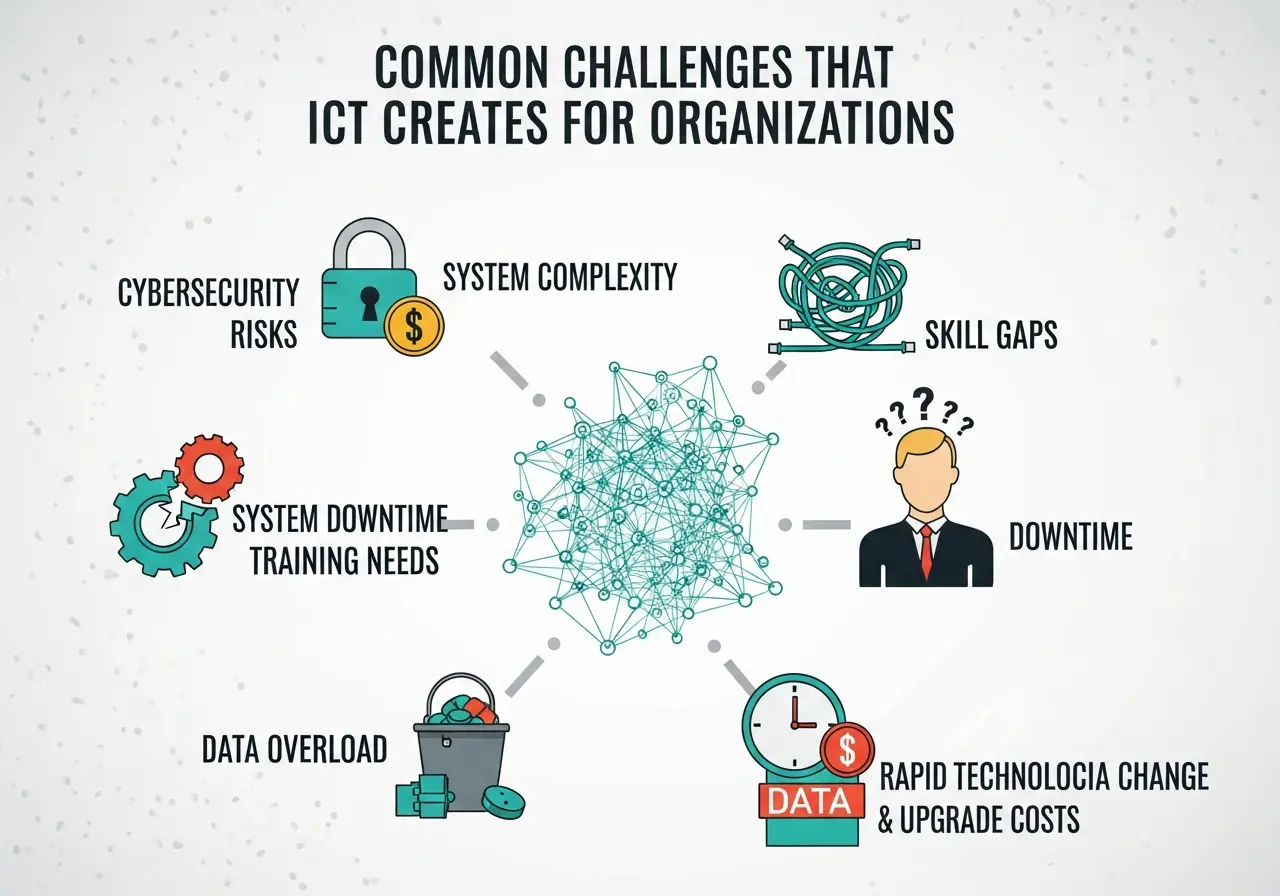What Is Information And Communication Technology (ICT)?
If you also think ICT is another normal techword, then pause. It quietly runs the scaffolding of modern life. It’s not just “computers & internet.” For example, from the moment an alarm on your phone nudges you awake to the second your payroll clears into a bank account, ICT (Information and Communication Technology) is the invisible engine making information flow, decisions happen, and connections form.

That means when a business talks about “ICT,” they’re committing to infrastructure (networks, servers), software (apps, databases), communications (voice, video, messaging), governance (security, data protection), and human processes (skills, support contracts).
What Do We Mean by ICT
We can say that information and communication Technology (ICT) is like an umbrella term for technologies and tools that help us access, create, store, process, exchange, and present information. That means everything from your smartphone and apps, to the networks that transport data, to the software in the cloud, everything comes under ICT.
At Penieltech, we know that mastering information and communication technology is key to thriving in today’s connected world. This blog explores what ICT really means, how it stands apart from traditional IT, and why it’s become essential for businesses in the digital era.
Difference between ICT vs. IT
Now, most people get confused here. They often use ICT and IT (Information Technology) interchangeably, but there’s a useful distinction:
IT (Information Technology) focuses on computing systems: hardware, software, and data processing.
ICT (Information and Communication Technology) equals IT plus communications systems (telecoms, broadcasting, internet services), and often emphasizes real-world use cases (e-learning, telehealth, unified communications).
Core components of ICT

- Devices & hardware: Computers, mobile phones, tablets, network equipment, sensors. These are the endpoints we use to interact with information.
- Networks & connectivity: Wired and wireless networks, internet access, data transmission, telecommunications infrastructure. We can say this is the “glue” that connects endpoints.
- Software & services: Operating systems, applications, cloud platforms, collaboration tools, and cybersecurity. Without these, devices and networks just don’t make any sense.
- Data & Storage: Databases, data lakes, and cloud storage services that hold enterprise and personal data.
- Media & communication platforms: Social media, broadcasting, video/audio tools, messaging systems. These emphasise the communication side of ICT.
- People & governance: Apart from these, people are also part of ICT. They include developers, IT professionals, and others.
Trends reshaping ICT
If you’re also wondering where ICT is headed, and why you should care, here are a few major trends:
- Tools that support remote, real-time collaboration are not optional anymore; rather, they are now business-critical.
- The “Internet of Things” (IoT) and edge computing are expanding the ICT boundary. Devices are everywhere: they are generating data, requiring connectivity, and processing.
- Cloud computing now continues to shift how organisations deploy services, store data, and scale. It’s making ICT more accessible but also more complex from a security/governance standpoint.
- ICT is increasingly recognised not just as a driver of business, but as a tool for societal development (education, healthcare, governance).
Why ICT Is Important for Businesses Today
Operational efficiency: For businesses, ICT automates repetitive tasks, centralizes data, and drastically reduces manual overhead.
Customer experience & reach: There are countless digital channels (web, mobile, chat) that let businesses meet customers anytime and anywhere. Through these channels, they can personalize offers and also scale support.
Data-driven decisions: We all know that analytics, instant dashboards, and multiple AI models are able to turn raw data into actionable insights that ultimately help us to make faster and better decisions.
Resilience & continuity: Cloud services and distributed networks help companies survive during sudden outages and also assist in growing under unexpected demand.
Competitive innovation: Companies that integrate ICT into product design, logistics, and service models are able to unlock new revenue streams and business models.
Common Challenges that ICT Creates for Organizations
We agree that ICT brings huge benefits, but there are some pain points too:

Security & privacy: Sometimes, more connectivity with multiple cloud platforms can create a larger attack surface. So you must keep pace with technology so that you can protect your valuable data.
Legacy complexity: Legacy systems, lots of disconnected data, and poorly documented interfaces always lead to slow projects. In this scenario, if you think about running hybrid estates, they can be extremely costly to integrate and maintain.
Skills gap: Employees and users may lack training or digital literacy to use modern ICT systems efficiently. Which means if you adopt new ICT (cloud, AI, DevOps) without providing proper training, then it can outpace available talent, forcing expensive hiring or training programs.
Practical Takeaways
- So, treat ICT as a business strategy and tie your investments to measurable outcomes (revenue, cost, risk).
- Start by building an ICT map with inventory devices, networks, apps, and governance policies, and identify each point of failure.
- It’s high time you invest in people. Upskilling and clear operating models reduce the hidden costs of tech adoption.
ICT & the Impact of the Digital Divide
The digital age supercharged ICT with multiple cloud platforms, mobile broadband, and cheap sensors. This means information flows faster and ideas scale quicker than ever. But there’s a flip side: not everyone is connected, and that gap has real economic and social consequences.
Recent reporting and analyses estimate that around 2.6 billion people remain offline - disproportionately in rural, low-income, and marginalized communities. That lack of connectivity constantly limits access to education, healthcare, finance, and markets, which deepens inequality and reduces the global economy’s growth potential.
For businesses, the takeaway is twofold: first, addressing access inequality can open new markets and talent pools. Second, companies have a responsibility to design products and services that work across low-bandwidth and resource-constrained environments.
So, if you take one thing from this, let it be this: investing in ICT wisely means thinking about how those tools serve people, processes, and purpose. If you can’t do it alone, then choosing a reliable IT AMC in Dubai ensures your business’s technology runs smoothly, along with achieving this goal.
